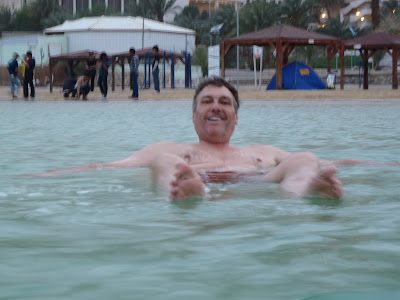We traveled by bus from the Sea of Galilee to Jerusalem. Jerusalem is 3,800 feet above sea level so your really "going up" or in the Hebrew "Aalyiah" to the High Places. Mt. Zion is really Mt. Horeb the place where Abraham went to sacrifice Isaac. Muslims believe it is the place where Abraham went to sacrifice Ishmael. The Western Wall, or "wailing wall" is the one surviving wall of Herod's Temple from Jesus day. However where the Holy Place was is now in the Dome of the Rock.
 |
| Wailing Wall |
We spent some time here in prayer and even tucked names of loved ones and others into the wall. It was a profound and moving place to pray with our Jewish brothers and sisters. I prayed for the Peace of Jerusalem as Scripture invites us to do. The next morning was Shabbat (Sabbath) so the Jewish part of Jerusalem was quiet but the Muslim quarter was busy. We went through the Damascus Gate into the Old City and the marketplaces. This gate and much of the existing wall was built by Suleiman the Magnificent in 1537.
 |
| Damascus Gate |
At Beth Gurin (House of Power) we learned about the importance of Olive oil for live and saw some underground olive presses. It is perhaps one like this that Samson was chained to after being captured. Oil was prosperity and power.
 |
| Olive Press |
 |
| Olive Press |
 |
| Columbarium- Underground Homing Pigeon coop |
The next day we began descending a long stairway in Hezekiahs Water Tunnel. Hezekiah built this to bring the Gihon Spring from outside the walls of Jerusalem to inside the walls when the Assyrians were preparing to attack Jerusalem. Its a remarkable engineering feat for the 8th Century BC with teams digging the rock from each end. It flows about 1/4 of a mile into the Pool of Siloam as it has flowed for
thousands of years.
Also under the city is "Solomon's Mine" where limestone was quarried, perhaps for the temple. Since no hammer or chisel was heard while the temple was built perhaps all the stone was mined and finished right under the city and then transported to the temple mount.
 |
| Solomon's Mine- under Jerusalem |
 |
| view of Old City & Dome of the Rock - Wailing wall behind it. |
 |
| Garden of Gethsemane |
 |
| Via Delarosa |

 That evening we traveled south to the Dead or Salt Sea. From the green and high places of Jerusalem we go to 1400 feet below sea level to a dry and barren place in the Judea wilderness . You get an idea where the Israelites lived for 40 years and why they might have wanted to go back to the water & food of Egypt.
That evening we traveled south to the Dead or Salt Sea. From the green and high places of Jerusalem we go to 1400 feet below sea level to a dry and barren place in the Judea wilderness . You get an idea where the Israelites lived for 40 years and why they might have wanted to go back to the water & food of Egypt.But even in the desert there are springs of living water. We hiked up to the En Gedi spring which provides an oasis near the Dead Sea. It may have been places like this that David lived and hid out from Saul. It was easy to understand all the Biblical images such as Psalm 42 " As a deer pants for streams of water so my soul pants for you O God. After our faith lessons some of us went swimming under the falls
 |
| Qumran caves |
Some of us enjoyed hiking down.
From the pictures you get an idea of the dryness of this Judah wilderness. It never rains here.
We got home in time for a swim or should I say float in the Dead Sea before dinner.
I'll have another post tomorrow about the Jordan Wilderness including Petra and then Egypt.
I also just discovered that some of our group were doing a blog while we were there with some great pictures and writing if you want to see more. Just click HERE to see it










No comments:
Post a Comment